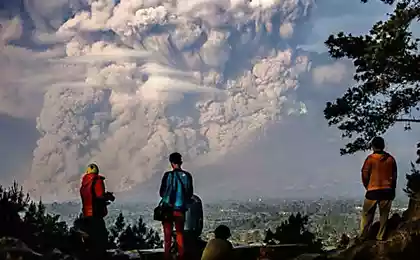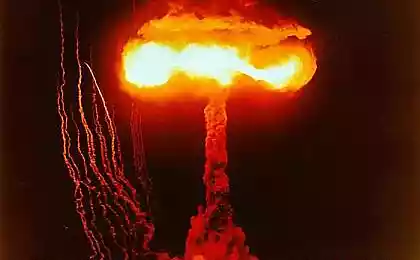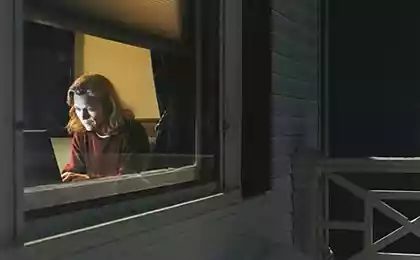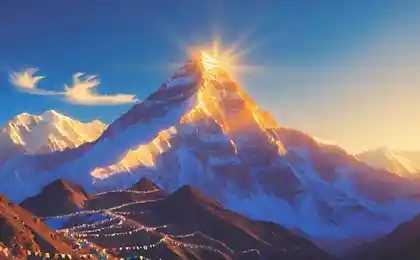503
Welcome to the anthropocene, people
The impact of humanity on the Earth so deeply and thoroughly that scientists had to admit the advent of a new geological era.
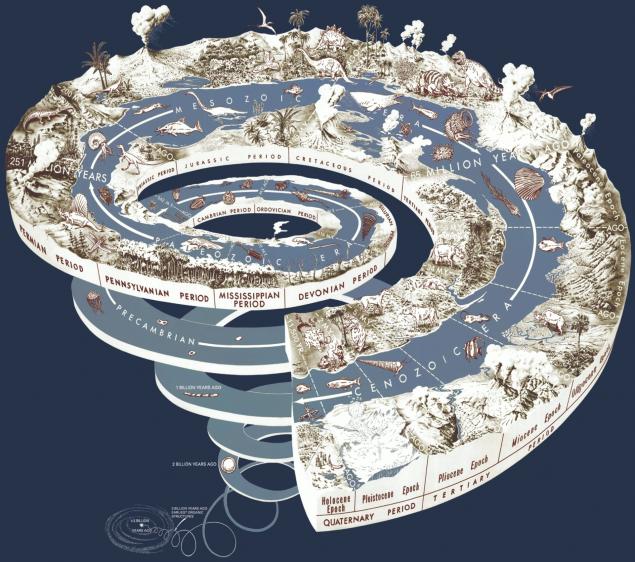
The geologic time scale, shown in the form of a spiral
A working group of 35 experts Working Group on the Anthropocene has adopted a final position and yesterday sent an official letter to the participants of the International geological Congress, which started on 27 August in Cape town. Scientists propose to formally announce the end of the geological era of the Holocene (the Holocene is the Epoch on the scale at the top) and the occurrence of geological era of the anthropocene.
The formal date of the onset of a new era are considered to be 1950 — the date when, after the first nuclear tests of the 40-ies on the Earth's surface was formed a layer of radioactive elements. Although de facto a fundamental irreversible changes in the earth's Geology and fauna began in the nineteenth century, after the industrial revolution.
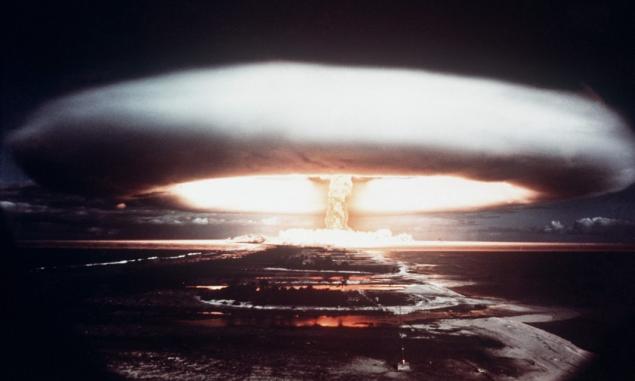
Nuclear testing on the Atoll Mururoa in French Polynesia in 1971. Photo: AFP / Getty Images
The clear geological marker of a new era — ubiquitous on the Earth's surface of radioactive elements from nuclear fallout. Scientists look for other markers that distinguish the anthropocene from the previous period of the Holocene, including the surface contamination of plastic waste (by 2050 the mass of plastic in the oceans exceeds the mass of fish), soot from power plants, concrete. Considered even such exotic token as a large number in the soil bones from poultry. In General, it considers all of the markers that will enable the geologists of the future to determine the soil layers that a certain event took place in the era of the anthropocene. Geological layer should be clearly visible in the soil after millions of years.
Future historians will be able to identify the historical layers of the anthropocene on radioactive elements absolutely and without a doubt — this was the reason for the almost unanimous consent of scholars to recognize the onset of a new geological era (voted"for" 30 of 35 experts working group, three against, two were absent).
Among other characteristics of the anthropocene mass extinction of flora and fauna (if present trend continues, 75% of species will disappear in the next centuries); the increase in carbon dioxide in the atmosphere most rapidly over the past 66 million years, doubling the amount of nitrogen and phosphorus in the soil over the last century (presumably the most significant change in the nitrogen cycle in the last 2.5 billion years), the appearance of a permanent layer of solid precipitation from the air (soot) in the glacial ice.
Now the Land is in the Quaternary period of the Cenozoic era (Quaternary).
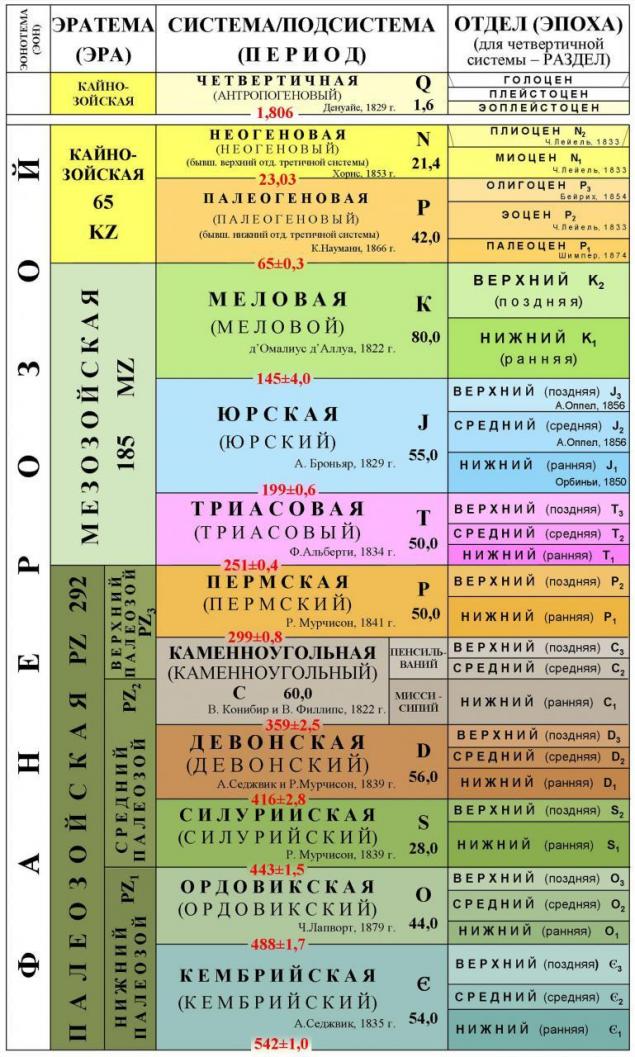
The Quaternary period (anthropogene) began to 2.58 million years ago, and the last epoch of the Holocene — the duration of the last 12 000 years.
The Holocene began after the fall of the meteorite in Mexico 13,000 years ago, and the abrupt end of the Last glacial maximum, with the mass extinction of the fauna and the emergence of human civilizations. From then until the nineteenth century the Earth's climate has remained relatively stable, the life of animals and plants have changed slightly.
Similarly, the Cretaceous period ended 66 million years ago after collision of Earth with a larger meteor that led to mass extinction of all dinosaurs naticia and 93% of mammal species on the planet. But geologically the end of an era is determined by the explosive growth of the content of iridium in strata of that is due to the massive sediments containing iridium, across the Earth after a collision with a meteorite.
"The importance of the anthropocene is that it sets a different path for the Earth system of which we are told on a press-conferences the Chairman of the working group, geologist Yang Zalasiewicz (Jan Zalasiewicz) of the University of Leicester. — If our recommendations [regarding the formal beginning of a new era in 1950] will be adopted, the anthropocene began just before my birth. We lived most of our lives in something called the anthropocene, and have just now begun to understand the scale and fundamental nature of change".
70 years on the Earth fell out enough radioactive fallout to form a stable and well-understood layer, according to the members of the working group, mentioning the presence in this layer of plastic minerals, both on land and in the ocean.
The discussion on the recognition of a new geological era is conducted for several years. Last year another group of scientists published a scientific paper in the journal Nature with the evidence to officially recognize the onset of the anthropocene.
However, scientists have not yet come to a consensus, on what specific date to define the beginning of the anthropocene. Some believe that the change began before the industrial revolution, namely by about 1610, when it was unusual decrease in the level of carbon dioxide in the atmosphere and irreversibly the exchange of species between the Old and the New world. Scientists believe that the global migration of species associated with the development of North and South America, European civilization and the beginning of international trade across the planet.
Now that a new geological epoch officially adopted by the participants of the working group, scientists begin the long process of studying the evidence in order to choose the most appropriate Dating on the chronological scale, Global Standard Stratigraphic Age (GSSA). This may be the year 1610, 1950 or some other date. After collecting evidence, the working group will issue a formal proposal to the International Commission of stratigraphy.
Following the approval of the International Commission on stratigraphy will require ratification by the Executive Committee of the International Union of geological Sciences. Then the anthropocene will be completely official and will make it into school textbooks. Team members remains a considerable work in the coming years, but they are confident that they will bring it to the end.
"Our stratigraphic colleagues are very protect geologic time scale. They very justly consider it as the basis of Geology and did not intend to make changes, " said Zalasiewicz. But we think we can prepare a pretty good business."
Source: geektimes.ru/post/279930/

The geologic time scale, shown in the form of a spiral
A working group of 35 experts Working Group on the Anthropocene has adopted a final position and yesterday sent an official letter to the participants of the International geological Congress, which started on 27 August in Cape town. Scientists propose to formally announce the end of the geological era of the Holocene (the Holocene is the Epoch on the scale at the top) and the occurrence of geological era of the anthropocene.
The formal date of the onset of a new era are considered to be 1950 — the date when, after the first nuclear tests of the 40-ies on the Earth's surface was formed a layer of radioactive elements. Although de facto a fundamental irreversible changes in the earth's Geology and fauna began in the nineteenth century, after the industrial revolution.

Nuclear testing on the Atoll Mururoa in French Polynesia in 1971. Photo: AFP / Getty Images
The clear geological marker of a new era — ubiquitous on the Earth's surface of radioactive elements from nuclear fallout. Scientists look for other markers that distinguish the anthropocene from the previous period of the Holocene, including the surface contamination of plastic waste (by 2050 the mass of plastic in the oceans exceeds the mass of fish), soot from power plants, concrete. Considered even such exotic token as a large number in the soil bones from poultry. In General, it considers all of the markers that will enable the geologists of the future to determine the soil layers that a certain event took place in the era of the anthropocene. Geological layer should be clearly visible in the soil after millions of years.
Future historians will be able to identify the historical layers of the anthropocene on radioactive elements absolutely and without a doubt — this was the reason for the almost unanimous consent of scholars to recognize the onset of a new geological era (voted"for" 30 of 35 experts working group, three against, two were absent).
Among other characteristics of the anthropocene mass extinction of flora and fauna (if present trend continues, 75% of species will disappear in the next centuries); the increase in carbon dioxide in the atmosphere most rapidly over the past 66 million years, doubling the amount of nitrogen and phosphorus in the soil over the last century (presumably the most significant change in the nitrogen cycle in the last 2.5 billion years), the appearance of a permanent layer of solid precipitation from the air (soot) in the glacial ice.
Now the Land is in the Quaternary period of the Cenozoic era (Quaternary).

The Quaternary period (anthropogene) began to 2.58 million years ago, and the last epoch of the Holocene — the duration of the last 12 000 years.
The Holocene began after the fall of the meteorite in Mexico 13,000 years ago, and the abrupt end of the Last glacial maximum, with the mass extinction of the fauna and the emergence of human civilizations. From then until the nineteenth century the Earth's climate has remained relatively stable, the life of animals and plants have changed slightly.
Similarly, the Cretaceous period ended 66 million years ago after collision of Earth with a larger meteor that led to mass extinction of all dinosaurs naticia and 93% of mammal species on the planet. But geologically the end of an era is determined by the explosive growth of the content of iridium in strata of that is due to the massive sediments containing iridium, across the Earth after a collision with a meteorite.
"The importance of the anthropocene is that it sets a different path for the Earth system of which we are told on a press-conferences the Chairman of the working group, geologist Yang Zalasiewicz (Jan Zalasiewicz) of the University of Leicester. — If our recommendations [regarding the formal beginning of a new era in 1950] will be adopted, the anthropocene began just before my birth. We lived most of our lives in something called the anthropocene, and have just now begun to understand the scale and fundamental nature of change".
70 years on the Earth fell out enough radioactive fallout to form a stable and well-understood layer, according to the members of the working group, mentioning the presence in this layer of plastic minerals, both on land and in the ocean.
The discussion on the recognition of a new geological era is conducted for several years. Last year another group of scientists published a scientific paper in the journal Nature with the evidence to officially recognize the onset of the anthropocene.
However, scientists have not yet come to a consensus, on what specific date to define the beginning of the anthropocene. Some believe that the change began before the industrial revolution, namely by about 1610, when it was unusual decrease in the level of carbon dioxide in the atmosphere and irreversibly the exchange of species between the Old and the New world. Scientists believe that the global migration of species associated with the development of North and South America, European civilization and the beginning of international trade across the planet.
Now that a new geological epoch officially adopted by the participants of the working group, scientists begin the long process of studying the evidence in order to choose the most appropriate Dating on the chronological scale, Global Standard Stratigraphic Age (GSSA). This may be the year 1610, 1950 or some other date. After collecting evidence, the working group will issue a formal proposal to the International Commission of stratigraphy.
Following the approval of the International Commission on stratigraphy will require ratification by the Executive Committee of the International Union of geological Sciences. Then the anthropocene will be completely official and will make it into school textbooks. Team members remains a considerable work in the coming years, but they are confident that they will bring it to the end.
"Our stratigraphic colleagues are very protect geologic time scale. They very justly consider it as the basis of Geology and did not intend to make changes, " said Zalasiewicz. But we think we can prepare a pretty good business."
Source: geektimes.ru/post/279930/
Powerful anomalous radio signals from space, which is actively reported by the media, most likely of terrestrial origin
Whether the robots empathy?
